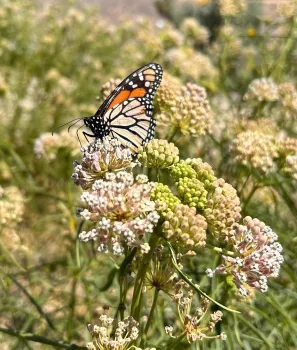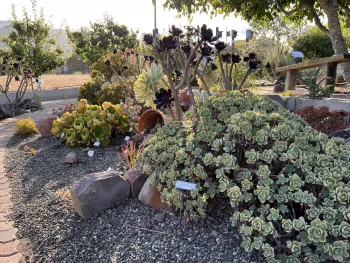Landscape Garden Plots
Curb Appeal Garden
As you enter the garden, the first display on the right is a section of the garden that we are calling "Curb Appeal." It includes ornamentals that create a garden with wow appeal throughout the year. The area represents a small garden space and how it can be most effectively used. The raised beds have been planted with a variety of long blooming, evergreen perennials leaving large enough spaces in between to be interplanted with seasonal color.
Additional pots are planted with seasonal flowers and small shrubs to create an inviting walkway. Each of the plants are labeled with identification and general information on culture and uses. All the plants have been selected for easy culture, drought tolerance, non-invasiveness, and high impact. Most of the annual flowers are grown from seed.
California Native Garden

Fire Safe Garden
The Fire Safe plot shows principles of landscaping in zones as outlined by CalFire for fire risk reduction. These fire safe principles are especially important to gardeners who live in wild land and urban interfaces in San Luis Obispo County.
The plot utilizes plants and materials that are not easily ignited such as low growing herbaceous plants that are well hydrated, with few woody plants. The selected plants either have high moisture content in the leaves and stems that require little supplemental watering, or they create little biomass when burning. The selected plants are slow growing, accumulate minimal seasonal dead vegetation or leaf litter, and exhibit an open branching growth habit. They contain little or no flammable oils or resins. Plant and mulch choices, plant spacing, and maintenance also play an important role in reducing the risk of fire being carried from the landscape to a home or structure. Pruning and thinning are also required to reduce fire laddering and control fuel load.
This garden feature was funded by the San Luis Obispo County Community Fire Safe Council.
Succulents and Cacti
Succulents and cacti are beautiful plants with colorful leaves, interesting shapes and simple care.

The Succulent and Cactus Garden plot shows diversity in form, color, and size of a wide variety of succulents and cacti that grow well in San Luis Obispo County. There are plant selections that grow well in North County that need shade from summer heat, and are winter hardy. The garden displays succulents that grow well in pots of various sizes with options for plant grouping, as well as container plants.
Lawn Alternative Plot
Gardeners interested in sustainable, attractive alternatives to a conventional lawn will learn about different kinds of ground covers in this plot.

Wildlife Habitat Plot
The Wildlife Habitat plot demonstrates how to attract various types of wildlife into your landscape by providing four basic needs: food, water, cover, and space.

This garden plot has been certified by the National Wildlife Federation as a Certified Wildlife Habitat. It is also certified by the Monarch Watch as an official Monarch Waystation for providing milkweed, nectar sources and shelter for migrating monarch butterflies.
